Château Cantemerle
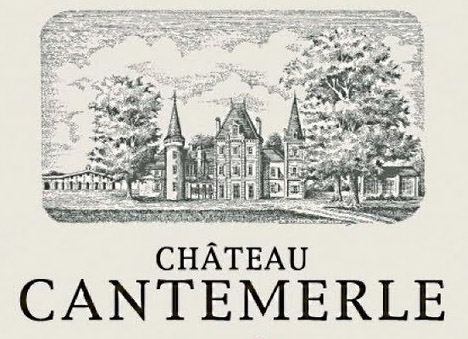
The Estate
The origins of Chateau Cantemerle date back to the Middle Ages; documents from the year 1354 reveal that viticultural production was a major aspect of the estate almost from the very beginning. It wasn’t until the 15th century, however, that wine making became the main industry of Cantemerle. Ownership of the Chateau changed hands many times over the centuries, from the Villeneuve de Durfort family in 1579, to the Dubos family in 1892. Today, it covers an area of about 90 hectares and is managed by SMABTP Group, one of the first insurance companies to take possession of a vineyard in Bordeaux.
The Soil
The soils of Cantemerle are a combination of silica and gravel which are the result of erosion of the Pyrenees by the Garonne 1,000 years ago. These soils have excellent filtration and good heat absorption, however they are poor in nutrients, resulting in hardy vines that produce grapes of high concentration.
The Vines
Cantemerle is planted with vines on average about 30 years old; 60% are Cabernet Sauvignon, 30% Merlot, 6% Cabernet Franc, and 4% Petit Verdot. Since the vines have to send their roots down deep into the soil in order to obtain the nutrients they require, the resulting grapes and wine express the terroir on an intimate level.
Vinification
There is a green harvest, and leaf thinning is practiced, with eventual yields up to 55 hl/ha. Hand selection is done in the vineyard, using 4 sorting tables. On arriving at the winery, the grapes are 100% destemmed before up to 30 days maceration and fermentation in conical wooden vats for the best parcels, stainless steel for the rest. A practice unique to Cantemerle is selective devatting, by which only the middle section of the cap is pressed. The upper layer, which includes oxidized grape matter, and the lower layers of pips and other materials, are not included. The wine then sees a year or so in oak with 50% new barrels each year, and only a light fining-no filtration-before bottling.
[/accordion_section]Wines and Production
The resulting grand vin is Château Cantemerle, with an annual production of about 25,000 cases. In addition, there is a second wine, Les Allées des Cantemerle, of which 12,500 cases are typically produced.

Chateau Cantemerle 5ème Grand Cru Classé Haut-Médoc
Production Area: 87 hectares
Soil: Silica and gravel of the quaternary era
Grape Varieties: 58% Cabernet Sauvignon, 33% Merlot, 6% Petit Verdot, 3% Cabernet Franc
Average Age of the Vines: 30 years old
Plant Density: 8,300 plants/ha
Growing Method: Médoc double Guyot; deleafing, grape thinning
Harvest: Manual with selective sorting in the vineyard; green harvest
Vinification: Total destemming, followed by hand-sorting before crushing of grapes. Fermentation lasts 6-8 days at a controlled temperature of 26-28C. Maceration for 28-30 days.
Aging: 12 months in French oak barrels (50% new wood). Ultra light fining is done prior to bottling, but no filtration
Tasting Notes: Clean and lively, with leather and prune notes. The structure is solid, with graceful tannins and volume on the palate.
Food Pairings: The Chateau Cantemerle is the perfect compliment to a grilled lamb chop

Les Allées de Cantemerle
Overview: This is the Second Wine of Chateau Cantemerle which is produced from the estate’s younger vines. Its is made using the same methods as the Grand Vin, and has similar characteristics but a shorter aging potential. This wine is made to be consumed within several years of the vintage.
Grape Varieties: Cabernet Sauvignon, Merlot, Cabernet Franc
Vinification: Total destemming, followed by hand-sorting before crushing of grapes. Fermentation lasts 6-8 days at a controlled temperature of 26-28C. Maceration for 28-30 days.
Aging: 12 months in French oak barrels and vats. Ultra light fining prior to bottling
Annual Production: 160,000 bottles
Tasting Notes: Consistently supple and elegant; Les Allées de Cantemerle has a full freshness and a delicate, pleasant fruitiness with notes of coffee and wild flowers. Fine tannins, low acidity, and subtle aromas.
Cellaring Potential: To be consumed in its youth or within several years of its vintage
2015 Reviews: “Tasted blind. Dark crimson. Sweet and intense. Edgy and demanding at the moment. A laster.” – 16+ pts, Jancis Robinson
Château Cantenac Brown

The Estate
At the beginning of the 19th century, John Lewis Brown (1769-1851) bought an estate in the village of Cantenac; it was a traditional Tudor style château which reminded him of his Scottish origins. His name is forever linked to the Grand Cru Classé. His grandson, John Lewis Brown (1829-1890) – esteemed animal painter and “Chevalier de la Légion d’Honneur” – spent time there during his childhood.
After the 1855 Grand Cru Classification, Louis Armand Lalande (1820-1894), Bordeaux wine merchant and owner of several estates in Médoc, expanded the estate.
José Sanfins presently manages Cantenac-Brown. He does his utmost to make the best of the magnificent terroir, lavishing the greatest of care on the soil and the vines, with great respect for the environment. This meticulous attention to detail continues into the cellar, where everything possible is done to produce an exceptional wine.

Château Cantenac Brown Margaux
Production Area: 48 ha
Soil: Gravelly
Grape Varieties: Cabernet Sauvignon, Merlot, and Cabernet Franc
Average Age of the Vines: 35 years old
Plantation Density: 8,500-10,000 vines/ha
Average Yield: 45 hl/ha
Pruning Method: Double Guyot; de-leafing, removal of secondary shoots, green harvest
Harvest: Manual harvest with 2 sorting operations (the first in the vineyard and the second before entering the vathouse)
Vinification: In temperature-controlled stainless steel vats. Vatting lasts 15-25 days. Malolactic fermentation occurs in barrels and vats.
Aging: In oak barrels for 12-15 months (50-70% new wood; 50-30% 1-year-old barrels). Racking is carried out every 3 months. Fining is done using egg whites.
Annual Production: 11,000 cases

BriO de Cantenac Brown
Overview: BriO is Chateau Cantenac Brown’s second wine. All plots are meticulously observed throughout the growth cycle from budding to the analysis of grape ripeness. The batches that are used to make Brio are chosen largely as a result of these observations.
Production Area: 48 ha
Grape Varietals: Cabernet Sauvignon, Merlot, and Cabernet Franc
Plantation Density: 8,500-10,00 plants/ha
Average Yield: 4,500 liters/ha
Pruning Method: Double Guyot; de-leafing, removal of secondary shoots, green harvest
Harvest: Manual harvest with 2 sorting operations (the first in the vineyard and the second before entering the vathouse)
Vinification: In temperature-controlled stainless steel vats. Vatting lasts 15-20 days. Malolactic fermentation occurs in barrels and vats.
Aging: In oak barrels for 12 months (20-25% new wood). Racking is carried out every 3 months. Fining is done using egg whites.
Annual Production: 7,500 cases
Tasting Notes: Deep, garnet color with crimson highlights. Nose of red fruit, vanilla, and oak. Harmonious, full, and velvety on the palate; warm, well-balanced, and lively. Seamless with a taut finish framed by freshness.
Château Carbonnieux


Overview
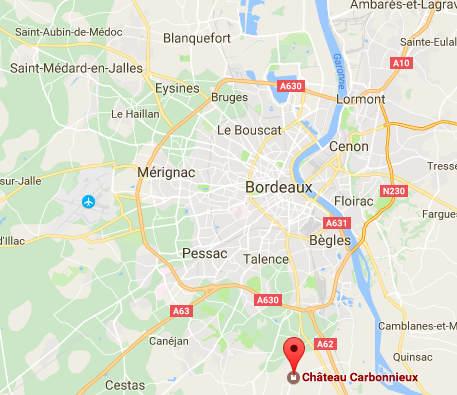
Located just ten miles from Bordeaux near the Garonne, the vineyards at Château Carbonnieux are situated on a rise in the land, on gravel rich soils typical of the area. Near neighbors include Smith-Haut-Lafitte and Haut-Bailly, both to the south. Château Carbonnieux is one of the classified Graves châteaux, and produces both red and white cuvées under the Pessac-Léognan appellation.
History
The medieval origins of the estate were confirmed by a deed of exchange dated April 2, 1292 signed by two monks from the powerful Sainte-Croix abbey in Bordeaux. In 1519 after the difficulties of the Hundred Years War, the Benedictine monks from Sainte Croix sold the Carbonnieux land to Jean de Ferron. Jean de Ferron who came from a powerful Bordeaux bourgeois family, that already owned vines, had recently been ennobled and to glorify his rank had to own a great vineyard in the Graves region. As new Lord of Carbonnieux, he started a land purchase and consolidation policy which continued under his successors for two and a half centuries.
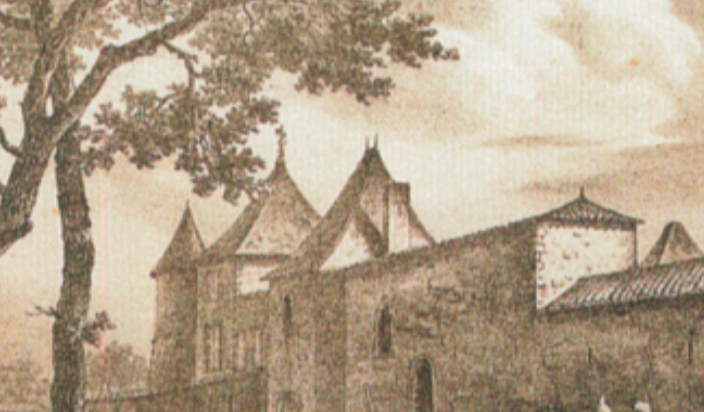 Formally a fortified farm, the Ferron noble house gradually became the great domain that it is today with its inner courtyard, high towers, outhouses, cropland and great vineyard. Although raised to the status of « Lords of Carbonnieux » the Ferron family ran into debt and sold the estate to the monks of the Sainte-Croix abbey in Bordeaux. Don Galléas was one of the first to blend varieties and to bottle wine which made it easier for it to be transported and kept for longer before being drunk. His vinification methods and his cellars were among the most modern in the region.
Formally a fortified farm, the Ferron noble house gradually became the great domain that it is today with its inner courtyard, high towers, outhouses, cropland and great vineyard. Although raised to the status of « Lords of Carbonnieux » the Ferron family ran into debt and sold the estate to the monks of the Sainte-Croix abbey in Bordeaux. Don Galléas was one of the first to blend varieties and to bottle wine which made it easier for it to be transported and kept for longer before being drunk. His vinification methods and his cellars were among the most modern in the region.
Thanks to the talents and entrepreneurship of the Benedictine monks from the Sainte-Croix abbey for half a century, the domain flourished and the famous bottle with the Saint Jacques shell attained worldwide renown, from Constantinople to the United States. In fact, during the 18th century when times were particularly good for the port of Bordeaux, the monks managed to introduce the clear white wines of Carbonnieux, with their pale colour into the palace of the Ottoman Sultan and called them « The mineral water of Carbonnieux ». The trick worked because one of his favourites was a woman from Bordeaux who had been captured by pirates and given to the Prince of the harem. The legend even goes so far as to say that the Prince asked « why do the French make wine when they have such delicious mineral water ? »
 In 1786, Thomas Jefferson, the future president of the United States, a gastronome and great wine lover went on a grand tour of France to discover its vineyards. In Bordeaux he selected a few famous estates and his diary shows that he came to Carbonnieux to taste the « Wine of the Odalisques » as it was then called in the United States.
In 1786, Thomas Jefferson, the future president of the United States, a gastronome and great wine lover went on a grand tour of France to discover its vineyards. In Bordeaux he selected a few famous estates and his diary shows that he came to Carbonnieux to taste the « Wine of the Odalisques » as it was then called in the United States.
There was a terrible frost in the winter of 1956 and it was this same year that Marc Perrin who had bought the estate, set to work on the renovation of the château and its vineyard. He first started a significant replanting campaign that took the estate to 45 Ha in 1970 then to 70 Ha in 1980, to reach almost 95 Ha today. His son, Antony, built a new fermentation cellar and modernized the cellars to adapt to new vinification methods. He continued the restoration of the château and the vineyards and focused on increasing the renown of Carbonnieux and Bordeaux wine throughout the world. He was president of the « Union of Grand Crus de Bordeaux », president of the « Crus Classés de Graves » as well as being one of the forerunners of the Pessac-Léognan appellation, created in 1987. He also purchased newestates in the appelation Château Le Sartre and bois Martin which today belong to his sister. Over the yeards he passed on the family winemaking heritage and his skills to his children. Today the torch has been passed on them and once again the estate has reached a peak.
The Terroir
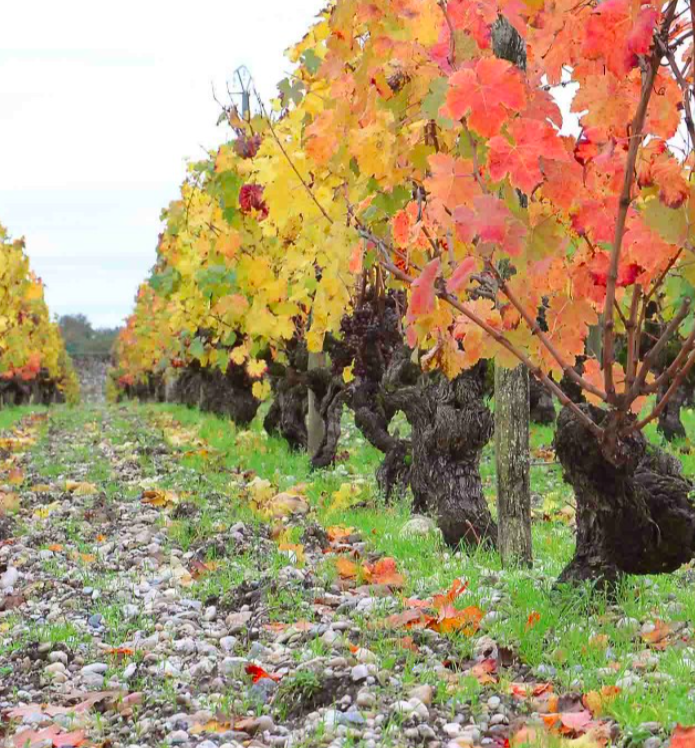 Sustainable agriculture classification for all the vineyard practices (chemical insecticides, weed-killers and acarides are banned).
Sustainable agriculture classification for all the vineyard practices (chemical insecticides, weed-killers and acarides are banned).
Carbonnieux is a member of the ISO 14001 Certified Bordeaux Environmental Management System Association.
Soil : Multiples plots with differents soils ; clay and gravel / gravel / clay and limestone / sand and gravel / argillaceous vein / limestone vein.
Acreage :
-50 Ha for red grape varieties (60% Cabernet Sauvignon, 30% Merlot, 7% Cabernet Franc, 3% Petit Verdot)
-42 Ha for white grape varieties (65% Sauvignon blanc, 35% Sémillon)
Harvesting : done by hand by local people who are familiar with the vineyards
Vinification
White
Little vibrating tippers place the bunches of harvested grapes gently on the sorting table. The white grapes, cleaned manually, arrive in three of the latest model pneumatic Inertys presses (under inert gas) where they are pressed, with or without the stems in oxygen free conditions. The first very clear aromatically subtle juices can be obtained after this type of slow gentle pressing. The absence of oxidation throughout the pressing process helps the naturally very pale juices to keep their fruity quality and to limit the use of sulphur. After 3 to 4 days of settling in vats at low temperature, fermentation continues in barrels, by batches depending on the plots they originally came from.
Red
Once they are placed on the table, the red grapes are sorted twice, before and after destemming, in order to get rid of any unwanted vegetable particles. After gentle crushing, the berries are put in vats with their skins to extract the tannins and the colour. The vatting process of red juices lasts around 28 days at low temperature and involves regular pumping over. The marc cap gently pumped over will give the wine the deep colour that characterizes the reds from Château Carbonnieux. When fermentation is finished the wines are drained by gravity into settling barrels, batch by batch , to start the ageing process.
Aging
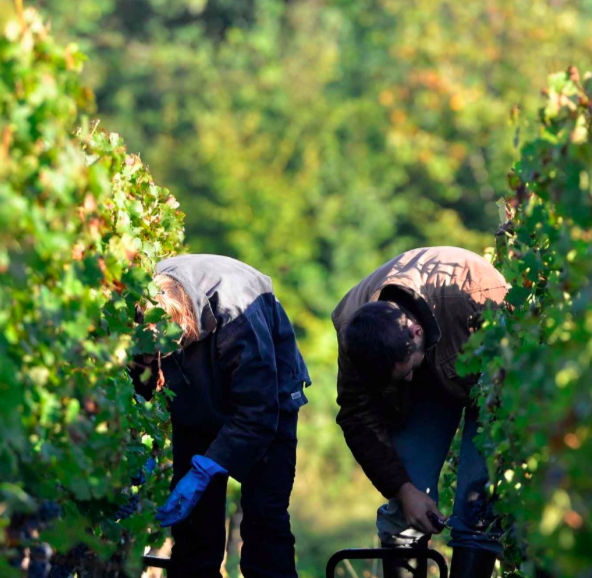 White
White
White wines are put in barrels of different capacities (225 litres, 400litres and oak vats) depending on the oak flavor desired. During the 10 months of ageing the different batches of white wines are stirred regularly. Thanks to this ancestral manual stirring process, the fine lees are suspended in the barrel to lend body and fullness to the wines.
The cellar for white wines contains the equivalent of 600 oak barrels from the centre of France. A quarter are renewed every year.
Red
Once they are barreled, red wines start the malolactic fermentation process which lowers acidity and gives them more roundness. The ageing of red wines lasts about 18 months in Bordeaux barrels. Slowly the tannins from the wood blend with those from the wine to produce more subtle aromas.
Oxygen that passes slowly between the staves of the barrels very gently matures the wine and the “angel’s share” is exhaled. Due to this natural loss the level of the barrels must be topped up regularly.
The red wine cellar contains around 1000 oak barrels from the centre of France. A third are renewed every year.
Blending
Each barrel is identified by its plot of origin and grape variety. At the end of the ageing process, blending gives life to the different wines. The best batches, offering outstanding gustatory qualities and cellaring potential, are selected for the red and white Carbonnieux wines. The other plots will be used to craft La Croix de Carbonnieux and Château Tour Léognan. After the painstaking blending process, the wines are fined (with egg whites for red wines and a natural mineral clay for white wines) to precipitate the last suspended micro-particles. The wines are then ready for bottling. The bottles rest in our cellars for a few months before delivery.
Crafted by the Perrin Family for more than a half-century, the great wines of Château Carbonnieux, red or white are then ready to join your cellar and grace your table.

Chateau Carbonnieux Rouge
Vinification: The vinification is carried out by slow and gentle extraction in order to preserve the roundness of the wine and the mineral features of the soil. The tannins are well balanced and silky in harmony with red fruit notes (blackcurrant, blackberry, cherry) and reveal toasted notes from aging in the finest quality French oak barrels. Only the very best batches tasted are selected for the final blending of Château Carbonnieux red.
Aging : 16-18 months in barrels (35% new oak)
Grape Varietals: Cabernet Sauvignon, Merlot, Cabernet Franc
Alcohol Content: 14%
Winemaker Notes: “Its deep colour, complexity and fruity intensity, freshness and tannic density allow you to imagine its enormous potential. A wine that can be kept for a very long time.”
Food Pairings: Grilled, roasted, or stewed meats, swordfish, tuna fish, cheese, chocolate desserts, etc.
Serving Temperature: 18-19°C
Cellaring Potential: 6 years minimum

Chateau Carbonnieux Blanc
Appellation: Pessac-Léognan
Production Area: 42 ha
Soil: Clay-gravel and clay-limestone
Average Age of Vines: 28 years
Grape Varieties: 60% Sauvignon Blanc, 40% Sémillon
Vineyard Management: Sustainable agriculture
Pruning: Cot or Guyot-poussart
Harvest: Hand harvesting. The grapes are sorted on the wine and on the sorting table.
Vinification: Gentle and slow pressing using inert gas – cold clarification. Fermenting and aging in oak barrels (2 volumes) and oak vats.
Aging: Barrel aging for 10 months (25% new oak) with lees stirring.
Alcohol: 13%
Production: 105,000 bottles
Average Yield: 25hl/ha

Château Tour Leognan Rouge
Overview: Château Tour Léognan was originally a separate estate bordering Château Carbonnieux. When Marc Perrin acquired the two properties in 1956 and began a program of replanting the vineyard, Château Tour Léognan became the second wine of Carbonnieux. From the start, its wines have been crafted from the young Château Carbonnieux vines (under 12 years old). Each year, 3 hectares (7.5 acres) are pulled up and replanted 2 or 3 years later.
A blend of Cabernet Sauvignon and Merlot, the red wines reflect the rich mineral variety of the soils, so specific to the Pessac-Leognan terroir. They are full-bodied, well-balanced and slightly oaky. Lively, aromatic, dynamic, and fruity, the white wines of Château Tour Leognan are decidedly very pleasant and easy to drink when young. The red wines are best enjoyed around 5 years old, and the whites around 3 years old.
Owner: SCEA A. Perrin & Fils
Co-Managers: Eric & Philibert Perrin
Vineyard Master: Freddy Flé
Oenologist: Andréa Perrin
Consultant: Christophe Ollivier
Appellation: Pessac-Léognan
Production Area: 10 ha
Soil: Deep gravel and clay-limestone
Grape Varieties: 60% Cabernet-Sauvignon, 40% Merlot
Planting Density: 7,200 vines/ha
Average Age of Vines: 8 years
Viticulture: Environmentally friendly growing for sustainable agriculture (Member of the 1st ISO 14001 certified Bordeaux EMS Association). HVE3 Labelled (High Environmental Value Level 3)
Training Method: Cot or Guyot-Poussart pruning
Harvest: Hand picking – 3 grape sortings
Vinification: Vatting 3-4 weeks in temperature-controlled stainless-steel tanks
Aging: Barrel aging for 12 months (30-40% new oak)
Tasting Notes: Round, fruity, and lightly oaked, making it easily approachable when young. Moreover, it is marked by the mineral notes and smoky character which is so appreciated in wines from Léognan.

Château Tour Léognan Bordeaux Blanc Sec
Overview: Château Tour Léognan is produced from young vines grown on the estate of Chateau Carbonnieux. Château Carbonnieux employs sustainable agriculture on all of its properties, meaning all chemical insecticides, weed-killers, and acaricides are banned and replaced by environmentally friendly methods that better respect biodiversity and allow the vine plant to stimulate its own natural defenses.
Production Area: 5 ha
Soil: Deep gravel & clay-limestone
Average Age of the Vines: 10 years old
Grape Varieties: 70% Sauvignon Blanc, 30% Sémillon
Vinification: The grapes are hand harvested with great care, then gently crushed in oxygen-free conditions using a pneumatic press. After 3-4 days of settling in vats at low temperature, fermentation continues in barrels by batches, depending on the plots they originally came from.
Aging: The wine is matured in 30% new oak barrels for 9 months, with lees stirring which lends body and fullness to the wine. After blending, the wine is fined using a natural mineral clay. The wines are then bottled and left to rest in the cellars for a few months before delivery.
Annual Production: 30,000 bottles
Tasting Notes: This wine is a pure pleasure to drink; there are notes of citrus in the bouquet and a fleshy, elegant mouth feel. This lively and fruity blend is rounded out by the sweetness and fattiness of the Sémillon grapes.
Food Pairings: Oysters, fish, seafood, raclette, white meat, goat cheese, citrus desserts
Serving Temperature: 12- 14°C
Château Chasse-Spleen
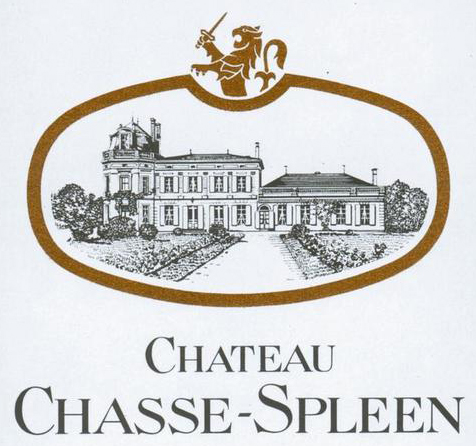
The Estate
Chasse-Spleen was originally one piece of a much larger estate in Haut-Médoc called Chateau Grand-Poujeaux. There was a split in 1822, and what was once Grand-Poujeaux became 4 smaller estates: Chateau Gressier-Grand-Poujeaux, Chateau Poujeaux-Theil, Chateau Maucaillou, and Chateau Chasse-Spleen.
The origins of the name “Chasse-Spleen” are foggy, but often attributed to Lord Byron who visited the estate in 1821. Byron was so moved during his stay that he was quoted as exclaiming, “Quel remede pour chasser le spleen!” or (loosely): “What better remedy to dispel melancholy!”
Chateau Chasse Spleen was owned by the Castaing family until the start of World War I when it was purchased by a German wine merchants. It was later confiscated as enemy property during the war and sold at an auction in 1922 to the Lahary family.
In 1976, the estate was bought by the Merlaut family, owners of Chateau Gruaud Larose, Chateau Ferriere, Chateau Citran, and Chateau Haut Bages Liberal, as well as a successful négociant business. Under the management of patriarch Jacques Merlaut and his daughter, Bernadotte Villars, several changes were made: the production area was increased from 40 to 80 hectares, large portions of the vines were replanted to increase vine density, and the wine making facilities were modernized.
Jacques’ daughter Bernadette later assumed control of Chateau Chasse Spleen, and with consultation from Emile Peynaud, the quality of the wines produced went up considerably. Bernadette and her husband sadly passed away in 1992 after a mountaineering accident, and management of the estate was passed on to her daughter, Claire Villars.

Château Chasse-Spleen Moulis-en-Médoc
Production Area: 80 hectares
Terroir: Gravel, clay, and chalk soil
Grape Varieties: 73% Cabernet Sauvignon, 20% Merlot, and 7% Petit Verdot
Average Age of the Vines: 30 years old
Plantation Density: 8,000-10,000 vines per hectare
Vinification: Vinified in a combination of stainless steel tanks and wooden vats. Malolactic fermentation takes place in vat.
Aging: In French oak barrels (40% new) for 12-15 months before bottling.
Cellaring Potential: 8-15 years
Annual Production: About 40,000 cases

L'Héritage de Chasse-Spleen Haut-Médoc
Overview: The history and evolution of a vineyard through inheritances, purchases, and regoupings of lands can lead to the association of several AOC within the same estate. Chasse-Spleen was established long before the AOC notion even existed, and as a result, some of its plots no longer belong to the same appellation. Today, they own 12 hectares in the appellation of Haut-Médoc. The INAO recognizes the notion of organization into a hierarchy for the Médoc AOC. This means that every single wine produced in Haut-Médoc and in communal appellations (Saint-Estèphe, Pauillac, Saint-Julien, Moulis, Marguax) is, before all else, a Haut-Médoc wine, while the opposite is not necessarily true. Only the plots that produce exclusively within these demarcated appellations may claim the communal AOC. In this way, some Moulis plots can lawfully also claim their Haut-Médoc appellation. This way, an average of 20 hectares of Haut-Médoc land produces l’Héritage de Chasse-Spleen.
At first known as Ermitage de Chasse Spleen, this wine had to be given a new name in 2000 because of homonymy reasons. Being born under the best auspices while inheriting all the care brought to the Grand Vin, this new name seemed very appropriate.
Tasting Notes: Brilliant garnet color. Aromas of cassis, black cherry, and a touch of minerality. Supple and fresh on the palate.
Château Chavrignac (Biodynamic)
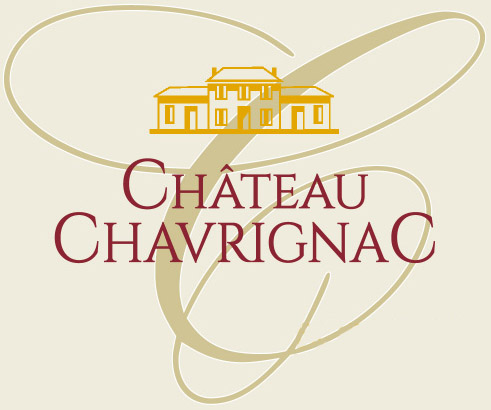
The Estate
This 32-hectare vineyard was founded by the Bouron family in 1964. Situated 60 km from Bordeaux in the Entre-Deux-Mers region between the Garonne and the Dordogne, Chavrignac produces Bordeaux that is well-balanced and fruit-forward. Apart from grapes, they also grow grains and raise animals – all cultivated in an organic and life-affirming spirit. Respect for nature and its rhythms is essential to them. The winery has employed organic methods of viticulture and vinification since 1964, and all the wines of Chateau Chavrignac bear the Ecocert certified organic stamp as well as the Demeter certified biodynamic stamp.

Château Chavrignac Bordeaux Rouge
Soil: Clay-limestone
Viticulture: The winemakers’ method of fertilization is based on compost, either of vegetable or animal origin. Natural grass cover guarantees the multiplication of predatory species of vine parasites. Copper-based treatments (Bordeaux mixture) are used, and sulfur treatment is reduced to a minimum. Certified organic and biodynamic.
Harvest: The grapes are harvested using both traditional and mechanical methods, with the greatest respect for the maximum maturity of each grape variety. A mechanical sorting table, assisted by 4 operators, guarantees that only the highest quality grapes are selected.
Vinification: The vinification is characterized by no inputs other than sulfur dioxide (<60mg/l) and pea proteins for pre-bottling stabilization.
Grape Varieties: 60% Merlot, 20% Cabernet Franc, 15% Petit Verdot, 5% Cabernet Sauvignon (percentages vary depending on the vintage)
Tasting Notes: The bouquet is frank and pure with notes of ripe blueberries, grilled peppers, and black pepper. On the palate, firm tannins with notes of wild mushrooms, leather, and mocha.
Château Cheval Blanc
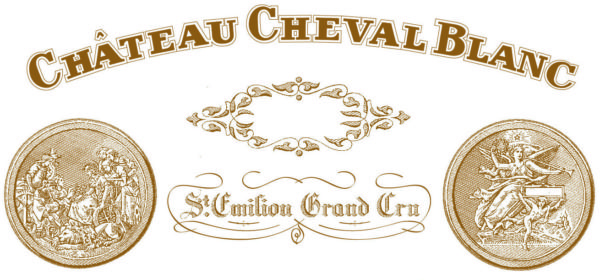
The Estate
Archives show that vines have been grown at Cheval Blanc at least as far back as the 15th century. The most prestigious part of Cheval Blanc’s history can be said to date from 1832, when Jean-Jacques Ducasse, President of the Libourne Trade Tribunal, purchased the core of the present-day estate. Over the next 20 years, the purchase of plots belonging to Château Figeac led to the creation of the 39- hectare vineyard as we know it today. The configuration has remained practically unchanged. The marriage of Jean-Jacques’ daughter, Henriette, with Jean Laussac-Fourcaud, a Libourne wine merchant, opened a new chapter in the history of Cheval Blanc that would define and consolidate the identity of this unique property.
After Henriette inherited Cheval Blanc, her husband undertook a spectacular renovation. He was among the first people to understand the importance of water stress to produce the finest wines and put in an efficient drainage system. However, the greatest progress made by the new owners was in the vineyard. Aware of Cheval Blanc’s outstanding potential, and helped by an extraordinary intuition, Jean Laussac-Fourcaud replanted part of the estate in the 1860s with a totally atypical proportion of grape varieties: half Merlot (the king of the Right Bank) and half Cabernet Franc. This replanting was finished in 1871. Formerly known as vin de Figeac, the wine was first sold under the name Cheval Blanc in 1852. This was the beginning of a prestigious career.
Cheval Blanc obtained the highest possible distinction in the first classification of Saint-Emilion wines in 1954: Premier Grand Cru Classé “A”. This exalted rank was confirmed in every following classification in each subsequent decade. Cheval Blanc became a member of the exclusive “Club of 9” comprising the first growths of Bordeaux.
A page was turned in autumn of 1998 when Bernard Arnault and Baron Albert Frère, two old friends and lovers of great wine, joined forces to became the owners of this fabled château in Saint-Emilion. They injected a dynamic new spirit, while respecting the château’s history and existing facilities. They also placed their complete trust in the winemaking team to continue their good work. The priority today is the ultimate in quality, which calls for enormous attention to detail and precision winemaking.

Château Cheval Blanc Saint-Émilion 1er Grand Cru Classé
Terroir: Château Cheval Blanc has an altogether unique terroir in Saint-Emilion. While most of the appellation’s other famous estates have limestone soil dating from the Tertiary Period, Cheval Blanc’s soil features alluvia from the Quaternary Period deposited by the Isle. And like most of the prestigious estates in Pomerol, Cheval Blanc’s soil formation has a varied texture that does not include limestone. However, Cheval Blanc is also different – and unique – in that the proportion of gravel and clay is just about equal. This gift of nature is essential in understanding the estate’s history.
Production Area: 39 hectares divided into 45 separate plots
Grape Varieties: 49% Cabernet Franc, 47% Merlot, and 4% Cabernet Sauvignon, with the goal of returning to the original mix of 55% Cabernet Franc, 40% Merlot and 5% Cabernet Sauvignon.
Average Age of the Vines: 45-100 years old
Plant Density: 8,000 vines per hectare, one of the higher levels of denser plantings found in the Right Bank.
Harvest: For the harvest, the estate does not wait until all the parcels achieve complete phenolic ripeness, instead picking the fruit when it is “al dente.” It is the winemakers’ view that the blending of grapes at different levels of ripeness from various parcels and terroir that adds complexity, freshness, and decadence to the wine.
Vinification: In 52 different temperature controlled, cement vats that vary in size. Malolactic fermentation takes place in tank.
Aging: 100% new, French oak barrels for about 18 months prior to bottling.
Technical Director: Pierre-Olivier Clouet
2013 Reviews: “Smoky aromas and layers of tannin and fruit give this wine great complexity. It is smooth, juicy and fresh while also having perfumed tannins and an elegant, lightly mineral structure from the Cabernet Franc. The wine’s cherries and red berries are still encased in the structure, allowing it to develop slowly.” – 95pts (Cellar Selection), Wine Enthusiast
2009 Reviews: “An impressive wine, a true return to form for Cheval Blanc. The fruit is enormous, packed with sweet black berry juice and with a brilliant freshness. There is a lovely smoky character, topped by ripe figs.” – 98pts, Wine Enthusiast
“Dense, brooding and richly coated, with a well of steeped black currant, fig paste and roasted plum fruit to draw on while the layers of charcoal, Kenya AA coffee and loam resolve themselves. This displays both breadth and depth, offering a great undercurrent of acidity to match its heft. Should be among the most long-lived wines of the vintage. Best from 2017 through 2035.” – 98pts, Wine Spectator
“Deep garnet colored, the 2009 Cheval Blanc offers up profound notions of baked blueberries, blackberry compote and crème de cassis with suggestions of chocolate mint, new leather and cloves plus a waft of candied violets. Medium to full-bodied, the palate is an exercise in elegance with very classy, super fine-grained tannins, beautiful freshness and layer upon layer of mineral-laced blue and black fruits, finishing long and perfumed.” – 100pts, Wine Advocate
2005 Reviews: “The 2005 from Cheval Blanc is a quintessentially elegant, beautiful, deep bluish/ruby-colored wine from St.-Emilion, with raspberry, blueberry, and floral notes, impressive density, great precision, freshness and purity. Full-bodied, but extremely light on its feet, I don’t mean to gush, but it is super-intense, rich and just so meticulously crafted! This is another fabulous wine and a perfect expression for this vintage. It is difficult to forget the gorgeous blueberry and raspberry fruit, full body, sweet tannin, a multi-layered texture, and purity and palate presence of this stunning wine.”-100pts, Wine Advocate

Le Petit Cheval Saint-Émilion Grand Cru
Overview: Le Petit Cheval is the second wine of Château Cheval Blanc, first produced in 1988. Approximately 10-12% of production of the estate goes into making this wine.
Soil: Limestone clay
Average Age of the Vines: 42 years old
Viticulture: Sustainable
Harvest: Manual
Vinification: In 52 different temperature controlled, cement vats that vary in size. Malolactic fermentation takes place in tank.
New Barrels: 50%
Grape Varieties: Cabernet Franc, Merlot
Alcohol: 13%
Château Clerc-Milon
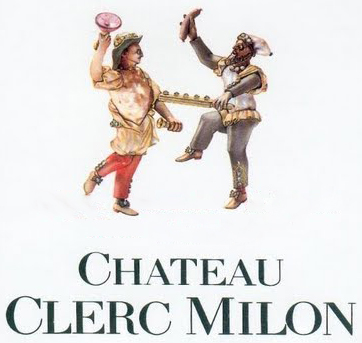
The Estate
Chateau Clerc Milon, classified as a Fifth Growth in 1855, is located on an exceptionally favorable terroir adjoining Lafite and Mouton. The estate was purchased by Baron Philippe in 1970 and is now owned by his daughter Baroness Philippine de Rothschild and her children. The vineyard spans 41 hectares in Pauillac, planted with the typical grape varieties of the region, including 49% Cabernet Sauvignon, 37% Merlot, 11% Cabernet Franc, 2% Petit Verdot, and 1% Carmenere. The average age of the vines is 52 years old, and the vine density is 10,00 plants per hectare.

Pastourelle de Clerc Milon
Overview: The product of an exceptional terroir, Pastourelle de Clerc Milon is the second wine of Chateau Clerc Milon, an 1855 Classified Growth at Pauillac. The “pastourelle” is a traditional dance which evokes a knight’s romantic encounter with a shepherdess; the name echoes the pair of dancers that adorn the label of the Grand Vin. Made of gold, enamel, and pearls, this precious miniature from the Museum of Wine in Art at Chateau Mouton Rothschild belonged to Catherine II, the empress of Russia, and is inspired by characters of the Commedia dell’Arte. Baroness Philippine de Rothschild chose it as the Clerc Milon emblem because of her love of the theater.
First Vintage: 2009 was the first vintage of Pastourelle de Clerc Milon.
Soil: Gravel
Grape Varieties: Cabernet Sauvignon, Merlot, Cabernet Franc, Petit Verdot, Carmenère (percentages differ depending on the vintage)
Harvest: The grapes are harvested in small crates
Vinification: Made from grapes grown in the vineyard of the Grand Vin, the second wine is vinified and bottled with the same meticulous care. Fermented in the Clerc Milon vat room.
Aging: Matured in oak barrels the traditional way.
Tasting Notes: A round and supple wine, Pastourelle de Clerc Milon charms with the elegant richness of its aromas and flavors. It is also living testimony to the considerable improvements in quality that have been achieved at the property since the arrival of Baron Philippe and his descendants. An elegant and rich Pauillac.
Château Clinet
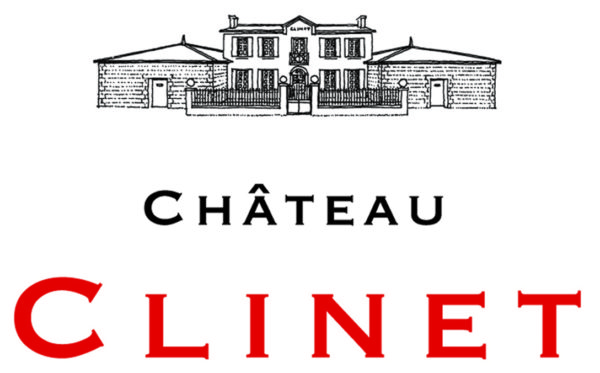
The Estate
When Jean-Louis Laborde bought Château Clinet back in 1999, his son Ronan was just 19 years old. Before that, they had traveled together to Argentina, looking at potential vineyards to purchase but destiny brought them back to Bordeaux, when the perfect property presented itself for sale. As soon as Ronan finished his studies, now aged 23, he became highly involved in the day-to-day management of Clinet, to the point that his father was soon able to comfortably take a step back and return to his former businesses. It didn’t take long for Ronan to see the full potential of Clinet, his instincts and expertise confirming that this château was worthy of worldwide recognition. For the past 10 years, he has devoted his life to producing the best quality wines, establishing gentle farming and vinification methods that respect the remarkable nature of the vineyard. A graduate of EDC Business School and the first generation of the Laborde family to be involved in wine production, Ronan is a genuine entrepreneur.

Château Clinet Pomerol
Location: Château Clinet is located at the highest point of the Pomerol plateau on the famous Günz gravel terrace, origin of the appellation’s most prestigious crus.
Vines: The vines are grown with total respect for the environment, giving pride of place to tilling and grassing rather than using chemicals, placing greater confidence in the human hand than in the profitability of the machine.
Production Area: 8.64 ha
Grape Varieties: 85% Merlot, 12% Cabernet Sauvignon, 3% Cabernet Franc
Average Age of the Vines: 45 years
Soil: Ancient gravel, deep clay, iron deposit in the subsoil
Viticulture: Tilling, natural grassing, barley
Harvest: Harvesting is always carried out manually. Following meticulous selection, gravity guides the harvested grapes to the vats in line with the harvesting plan.
Vinification: The vinification process aims to maintain the freshness, finesse and character of Château Clinet wines. On average, fermentation and maceration lasts for one month, before the wine is transferred into barrels. The ‘free run’ wines are separated from the ‘pressed’ wines, and then aged separately. The layout of our cellars allows good traceability from the vineyard to the end of the aging period. The production of a well-defined parcel can also be followed in each vat, then each barrel. After vinification, Clinet makes use of an automated vertical press, to extract the quintessence from the remnants of grape left in the vats. Rich in tannins, this ‘press juice’ may be used to bring structure to the final blend.
Aging: 60% new oak barrels, 40% one-year-old barrels
Tasting Notes: This outstanding wine, the result of the combination of a generous terroir, a friendly climate and human foresight, is unanimously hailed as one of the most prestigious wines in the world.
2008 Reviews: “Another resounding success for the vintage…the 2008 exhibits an inky/purple color as well as sweet creme de cassis, blackberry, plum, Asian spice, licorice and incense notes. Layered and full-bodied with stunning purity and a 40+ second finish…”-94+pts, Robert Parker
Château Clos de Boüard
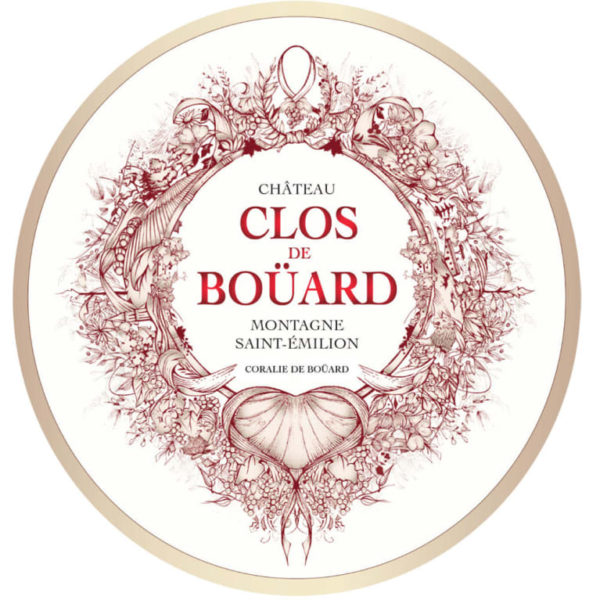
The Estate
Château Clos de Boüard has a well-exposed terroir, 30 hectares, in the town of Parsac, historically renowned for the richness and quality of its exceptional clay-limestone terroirs. Located near Grands Crus Classés and similar of Saint-Emilion: the castles Fombrauge, Laroque, Rocheyron, Croix de Labrie, Château Louis, Fleur Cardinale, Valandraud and Troplong Mondot.
The property benefits from a privileged biodiversity and ecosystem with a strong presence of old vines. Investments to restructure the vineyard are underway in order to produce high quality wines with silky, velvety tannins, respectful of the fruit, full of elegance, delicacy and freshness, wines that are the signature of know-how and family expertise.

Dame De Boüard
Grape variety: 60% Merlot, 30% Cabarnet Franc, 10% Cabernet Sauvignon
Vineyard area: 30 hectares
Appellation: Montagne Saint-Émilion
Soil type: Clay-limestone
Average age of the vines: 40 years
Production: 45 hecto/ha
Winemaker: Coralie de Boüard de Laforest
Aging: 10-14 months; 30% new barrels.
Harvest period: September 25th-October 9th.
Alcohol: 15%
2019 Reviews: “Deep garnet-purple colored, the 2019 La Dame de Bouärd offers up notes of Morello cherries, preserved plums and fruitcake with hints of espresso, forest floor and dried Provence herbs. Medium to full-bodied, the palate has a sturdy foundation of chewy tannins and just enough freshness to support the generous baked berries flavors, finishing with a peppery kick.” – 90pts, Wine Advocate
Château Corbin
The Estate
Anabelle Cruse-Bardinet, owner of Château Corbin, belongs to the long line of winemakers in the Cruse family. The story of the Cruse family in Bordeaux began in the 19th century, when Herman Cruse, a Danish merchant, came to Bordeaux to create a wine trade company. His son worked hard to develop this activity and acquired the first estates of the family in the Medoc vineyards with Chateau Pontet Canet (Pauillac, 5th Cru Classé) and Chateau Giscours (Margaux, 3rd Cru Classé). Since that time, the Cruse family has continued to invest up to their peak, 40 years ago. In addition to Chateau Pontet Canet and Chateau Giscours, the Cruse family also owned Chateau Rauzan-Ségla (Margaux, 2nd Cru Classé), Chateau Haut-Bages Libéral (Pauillac, 5th Cru Classé) and Chateau d’Issan (Margaux, 3rd Cru Classé). Chateau d’Issan remains in the family today and Emmanuel Cruse is in charge of this property. Their presence in the vineyard is not limited to this Cru Classé and the determination of the Cruse family to continue their story and to keep their domains alive is intact.
Owners: Anabelle Cruse and Sebastien Bardinet
Winemaker and Manager: Anabelle Cruse Bardinet
Consultant Oenologist: Jean-Philippe Fort from Laboratoire Michel Rolland

Château Corbin Saint-Émilion Grand Cru Classé
Classification: Grand Cru Classe
Appellation: Saint-Emilion Grand Cru
Location: In the commune of Saint-Emilion next to Pomerol appellation
Soil: Clayey and sandy-clay with ferric clay subsoil
Surface Area: 13 hectares (31.30 acres)
Grapes Varieties: 80% Merlot, 20% Cabernet Franc
Average Age of the Vines: 30 years
Rootstock: 3309, 101-14, Riparia
Plantation Density: 6,667 to 8,333 plants/hectare
Vines: Training method-Guyot simple. Integrated crop management, environmentally friendly viticulture.
Average Yield: 40 to 45 hectoliters per hectare
Harvest: By hand with small crates. 2 sortings, destemming, crushing
Vinification: Maceration at cold temperatures. Pneumatic press. 4 pumpings per day during the alcoholic fermentation period. Fermented in concrete vats coated with epoxy resin and automatic regulation at a temperature of 28°C for 3 to 4 weeks. Malolactic fermentation in new barrels.
Aging: 16 to 18 months in 100% in French oak barrels, 40 to 50% are new every year. Racking every 3 or 5 months. Chateau bottling.
Annual Production: 40,000 to 55,000 bottles
2014 Reviews: “The 2014 Corbin is round, supple and very nicely balanced. Restrained and mid-weight in style, the 2014 Corbin is a wine of harmony and proportion above all else. Silky tannins confer finesse to the dark, spiced fruit. This feminine, gracious St.-Emilion will drink well early.” – 91pts, Vinous

XX de Corbin
Overview: Just like the First Wine of Corbin, the flavorsome XX de Corbin is made from a very rigorous selection process. It benefits from the same care and attention as the First Wine. The aging process is simply shorter, since this Second Wine is bottled during the summer following the harvest, so as to preserve all the freshness of the fruit flavor.
Appellation: Saint-Emilion
Soil: Sand and clay on a ferruginous clay subsoil
Production Area: 13 ha (31.30 acres)
Average Age of the Vines: 31 years old
Annual Production: 6,000-8,000 bottles
Grape Varieties: Merlot 80%, Cabernet Franc 20%
Vinification: Manual harvest with sorting. Traditional temperature controlled vinification with long maceration.
Aging: Maturation for 16 months in barrels, 20% of which are new wood.
Tasting Notes: This wine leaves an impression of velvety lightness on the palate, with beautiful length and finesse on the finish.
Château Cos d’Estournel
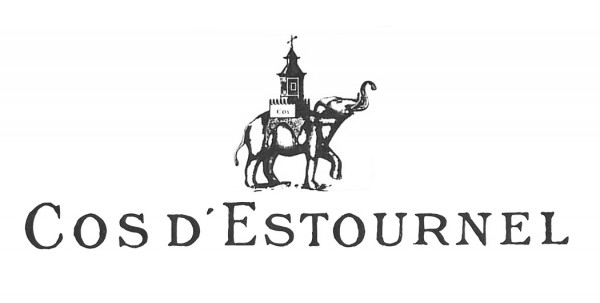
History
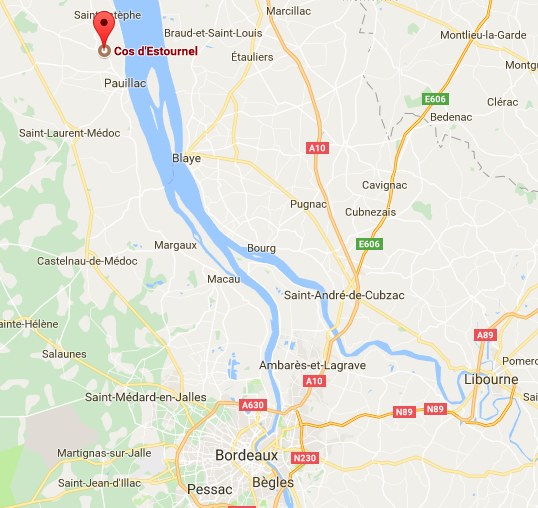
Louis Gaspard d’Estournel inherited Cos and Pomys in 1791. He expanded his vineyard from 14 to 45 hectares. Throughout his lifetime Louis Gaspard d’Estournel remained closely involved in the management of Cos d’Estournel. He fought endlessly to promote his estate, even if it meant having to sell it to finance his debts before acquiring it once again. Louis Gaspard d’Estournel would live to see his wine designated a Deuxième Grand Cru du Médoc by the negociants of Bordeaux but sadly enough, he passed away two years before the 1855 Bordeaux Classification officially recognized Cos d’Estournel as a Second Growth Estate.
Owner of Cos d’Estournel since 2000, entrepreneur Michel Reybier is a simple and discreet man. Moved by the extraordinary personality of the estate and the audacity of its founder, his decision to acquire was not motivated by financial considerations alone. For him, the choice was clear: it would be “Cos and only Cos.” Today he remains deeply attached to his vineyard. “At first glance, I was attracted by the history of the place. And then when I visited the estate, I felt instantly how unique, how exceptional it is.” Michel Reybier is an active presence throughout the year and a major actor in the estate’s development. In this he resembles his predecessor Louis Gaspard d’Estournel, with whom he also shares a profound passion for Cos d’Estournel.
Terroir
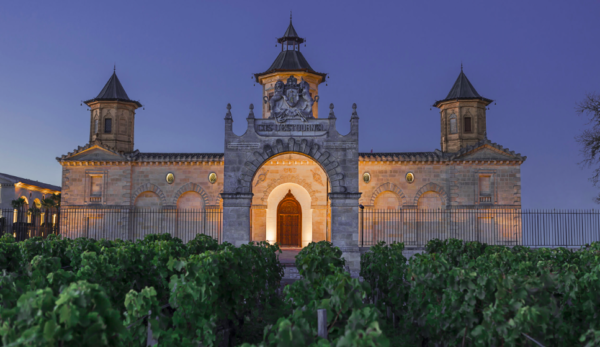 Cos d’Estournel is ideally situated at the heart of an undulating landscape in the northern Médoc. A plateau of deep gravel comprises the core of the site. Gravelly and clayey, the two hills that slope downward from this point benefit respectively from eastern and south-southwestern exposures. These geologic features are completed by a clay vein running diagonally through the vineyard. Merlot is found to the east, on clay-limestone soils, while Cabernet Sauvignon is grown on the highest parts of the plateau, where drainage is ideal. A near miracle in geographic and geologic terms, Cos d’Estournel benefits from an unparalleled combination of soils and exposures. The northernmost village appellation of the Médoc, Saint-Estèphe is nestled between the Gironde Estuary and the Atlantic Ocean. More pronounced than elsewhere in the region, the resulting oceanic climate tempers extreme weather conditions; winters are less harsh and summer heat waves less intense. Ripening occurs gently, which favors complexity and freshness of aromas in the grapes.
Cos d’Estournel is ideally situated at the heart of an undulating landscape in the northern Médoc. A plateau of deep gravel comprises the core of the site. Gravelly and clayey, the two hills that slope downward from this point benefit respectively from eastern and south-southwestern exposures. These geologic features are completed by a clay vein running diagonally through the vineyard. Merlot is found to the east, on clay-limestone soils, while Cabernet Sauvignon is grown on the highest parts of the plateau, where drainage is ideal. A near miracle in geographic and geologic terms, Cos d’Estournel benefits from an unparalleled combination of soils and exposures. The northernmost village appellation of the Médoc, Saint-Estèphe is nestled between the Gironde Estuary and the Atlantic Ocean. More pronounced than elsewhere in the region, the resulting oceanic climate tempers extreme weather conditions; winters are less harsh and summer heat waves less intense. Ripening occurs gently, which favors complexity and freshness of aromas in the grapes.
The wind that often blows through the vineyard is also essential: by drying excess humidity and purifying the air, it allows grape berries to ripen on the vine in perfect health.
Today the vineyard occupies 91 hectares. Cabernet Sauvignon accounts for two-thirds of this precious mosaic of 61 plots, with a lesser proportion of the land dedicated to Merlot and a small proportion to Cabernet Franc and Petit Verdot. Nestled among the vine plants of the estate—45 years old on average—are certain very precious specimens, guardians of the vineyard’s heritage. Some of the oldest vine plants date back to the early 20th century. They continue to thrive, finding nourishment in the deepest layers of the land. Their grapes bring depth and structure to the wines of Cos d’Estournel, a testament to the incomparable complexity of the vineyard’s soil. The grapes from these mature plants are blended with the fruit of their younger counterparts to produce the Grand Vin of Cos d’Estournel. The average age of vine plants whose grapes are used in the estate’s first wine is 55 years old.
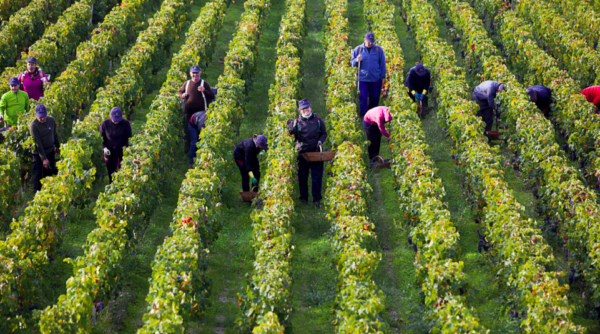 Keeping the oldest vine plants alive is crucial to perpetuating Cos d’Estournel’s rich heritage. Despite their low yield and the special care they require, these plants produce the grapes that shape the core identity of the estate’s wines. They also ensure the continuity of the vineyard through massal selection. Grapes are examined and tasted to identify the plants that most closely represent the singular qualities of the estate’s terroir. Their shoots are then used to grow young vines, so that the defining characteristics of Cos d’Estournel may be passed down from one generation to the next. It is a time-consuming process that requires great commitment, first during the selection process and then in caring for the young vines until they are mature enough for their grapes to be used in the Grand Vin. But this measure is essential to preserving the unique signature of the wines of the estate. Each vine-grower on the estate is entrusted with the same ten plots, or forty thousand vine plants, year after year. He or she follows them closely from one season to the next and is entirely responsible for their care.
Keeping the oldest vine plants alive is crucial to perpetuating Cos d’Estournel’s rich heritage. Despite their low yield and the special care they require, these plants produce the grapes that shape the core identity of the estate’s wines. They also ensure the continuity of the vineyard through massal selection. Grapes are examined and tasted to identify the plants that most closely represent the singular qualities of the estate’s terroir. Their shoots are then used to grow young vines, so that the defining characteristics of Cos d’Estournel may be passed down from one generation to the next. It is a time-consuming process that requires great commitment, first during the selection process and then in caring for the young vines until they are mature enough for their grapes to be used in the Grand Vin. But this measure is essential to preserving the unique signature of the wines of the estate. Each vine-grower on the estate is entrusted with the same ten plots, or forty thousand vine plants, year after year. He or she follows them closely from one season to the next and is entirely responsible for their care.
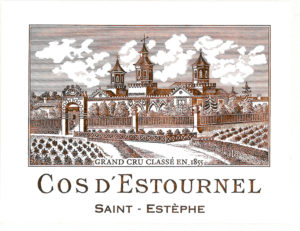
Château Cos d'Estournel Saint-Estèphe 2ème Grand Cru Classé
Overview: Cos d’Estournel has become, in the eyes of lovers of fine wine, the archetype of a certain style of masculine elegance in which immense power is combined with grace and smoothness. Impressive when young for the intensity of its structure and explosive fruit, Cos d’Estournel evolves slowly to arrive, when completely mature after.
Grape Varietals: 74% Cabernet Sauvignon, 23% Merlot, 3% Cabernet Franc
Maturation: Aging takes place in 80% new barrels
Cellaring Potential: 2012-2035
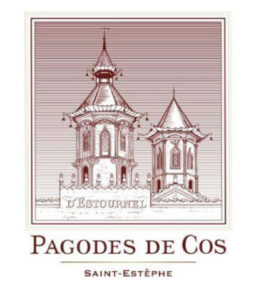
Les Pagodes de Cos
Overview: Les Pagodes de Cos is, strictly speaking, Cos d’Estournel’s “second wine”. The vines that produce it are eventually used for the “Grand Vin” which is an 1855 Grand Cru Classé. They are grown on the same terroir and are treated in the same way. They are simply younger and their roots have yet to grow to their full depth in the gravelly soil. Powerful, very aromatic, long on the palate, with a very persistent finish, Les Pagodes de Cos is a wine of refinement and pleasure.
Location: The terroir of Les Pagodes de Cos, which translates to “Hill of Pebbles”, is made up of gravel on top of the limestone plateau of Saint-Estèphe and is separated from the vineyards of Château Lafite by a small stream.
Grape Varieties: 62% Cabernet Sauvignon, 38% Merlot
Vinification: Once the hand-picked grapes are brought to Cos’ modern cellar, which can be altered to provide the vinfication best suited to the vintage, the wine is fermented, blended, and aged in oak for 12 months.
Tasting Notes: Les Pagodes de Cos is a very elegant wine in the glass; it has a deep ruby coloring with a nose of red fruit, tobacco, and spices. The palate has great balance, allowing the wine to express its youthful intensity and sensual texture without becoming overpowering. The poise of Les Pagodes de Cos in the mouth showcases the exceptional winemaking of Jean-Guillaume Prats, described by Robert Parker as a “winemaking guru”. This wine effortlessly demonstrates the greatness of the Cos d’Estournel terroir and is a very special bottle of Bordeaux. It would make a magnificent gift, or be wonderful alongside a memorable dinner.
Cellaring Potential: To be drunk within 10 years of its bottling at the Château.
Château Cos Labory
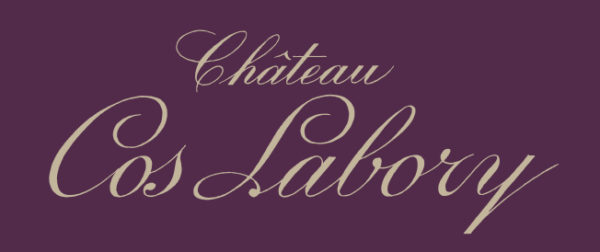
The Estate
The name of the estate is derived from its situation on the Cos hill, and the name of François Labory who was the first owner until 1845.
Louis Gaspard d’Estournel then acquired it before having to sell it again to an English banker, Charles Martyns in 1852. The property was finally taken over by George Weber in the 1930’s, who bequeathed it to his daughter and son-in-law, François Audoy in 1959. In 1971, the couple acquired the neighboring estate, Château Andron Blanquet. Their sons worked with them on the two estates for a few years and then the elder Bernard took over the running of the properties. Bernard is a strong, practical manager with a quiet reassuring manner. He has always lived in Saint-Estèphe and is perfectly emblematic of his estate, his wines and the appellation that he has presided over since 2000.
A real family property, where the generations have genuinely labored already for nearly a century for the estate to blossom and grow.

Château Cos Labory Saint-Estéphe 5ème Grand Cru Classé
Overview: Made from fruit from the best plots on the Cos hill, Château Cos Labory combines characteristic Saint-Estèphe vigour and elegance. Its rich tannin content gives this wine good ageing potential.
Appellation: Saint-Estèphe
Production Area: 18 hectares (44.5 acres)
Soil: Gunz gravel over a marly limestone subsoil
Grape Varietals: 60% Cabernet Sauvignon, 35% Merlot, 5% Cabernet franc
Average Age of the Vines: 35 years
Planting Density: 8,700 vines per hectare
Vinification: Carried out in temperature-controlled stainless steel tanks
Aging: Performed in oak barrels (50% in new casks)
Annual Production: 100,000 bottles
2010 Reviews: “This wine seems like it’s all structure at this stage, firmly tannic and dry. Very solid and chunky, it is hiding its potentially rich fruit, which will show once the intense tannins soften, but the wine will likely always be severe.”-91pts, Wine Enthusiast




